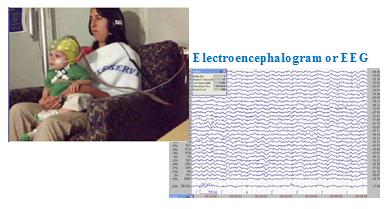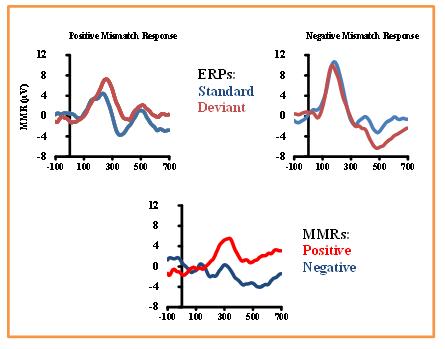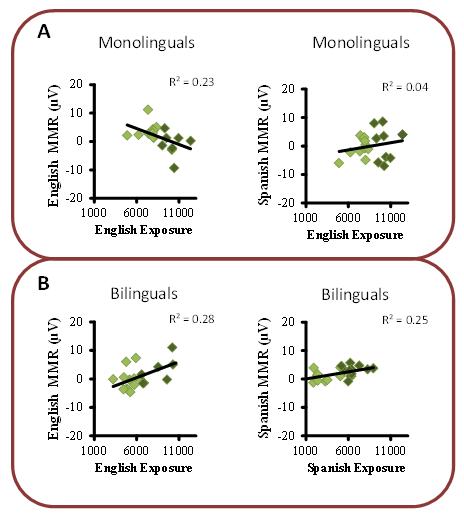
Adrian Garcia-Sierra-gasa@uw.edu
Nairan Ramirez-Esparza-nairan@uw.edu
Patricia K. Kuhl-pkkuhl@uw.edu
Institute for Learning & Brain Sciences
University of Washington
Box 357988
Seattle, WA 98195
Popular version of paper 1aSCa6
Presented Monday morning, May 14, 2012
163rd ASA Meeting, Hong Kong
Previous research has shown that exposure to a language influences the way monolingual infants perceive speech sounds. By one year of age infants neurally commit to the speech sounds that are native to their language and they decline in their ability to discriminate sounds that are not native to their language (Best & McRoberts, 2003; Kuhl et al., 2006; Werker & Tees, 1984). This pattern of perceptual change leads to the question: how do infants who are exposed to two languages perceive speech sounds that are native to their languages? In order to answer this question, we recruited Spanish-English bilingual infants from the San Antonio Texas area and we measured their abilities to discriminate speech sounds by using Event Related Potentials or ERPs (Garcia-Sierra et al., 2011). Figure 1 shows an infant whose brain waves are being assessed while the infant is entertained by a toy waver and is listening to speech sounds.

In order to learn if bilinguals were able to discriminate speech sounds that are native to their languages (English and Spanish), during the ERP sessions we deliver a repetitive background sound (standard) followed by a target sound (deviant). The electric brain activity is time-locked to the presentation of the sounds and then averaged off-line to obtain the brain responses (ERPs) to the standard and deviant sounds. In Garcia-Sierra and colleagues (2011) we investigated a brain component that has been used in other studies to assess speech discrimination: The mismatch response or MMR (Naatanen, 1992). This response can be negative or positive. Figure 2 depicts the brain responses to the standard and the deviant speech sounds as well as the algebraic difference between standard and deviant (MMR). A positive MMR seems to be present when babies begin neural commitment to their language but have not completed it, and negative MMRs seem to be present in babies that have formally committed to their language (see Garcia-Sierra et al., 2011).
Figure 2. ERP Responses Depicting Positive and Negative MMRs

In the Garcia-Sierra et al. (2011) study we showed that 6-8 month-old Spanish-English bilinguals with high exposure to English showed positive MMRs. 10-12 month-old bilinguals with high exposure to English showed negative MMRs. The same pattern was found for bilingual infants with high or low exposure to Spanish. This pattern of results suggested that as bilinguals gained more exposure to their native languages the MMRs transitioned from positive (immature) to negative (mature) response. Garcia-Sierra and colleagues' study was one of the first studies that looked at bilingual infants' exposure to each of their languages and their perception of speech sounds assessed by means of ERPs. The current study replicates this experiment with older bilingual children (11-14 months), and adds a monolingual group of infants to make direct comparisons. This is the first study relating monolinguals' and bilinguals' amount of language exposure (English and/or Spanish) with their ability to discriminate these languages.
Goals of the study
In the present investigation we assessed speech discrimination of two speech contrasts (English and Spanish) by means of the MMR. We hypothesized that monolinguals with high exposure to English would show commitment (negative MMRs) to the English speech sounds, but would not show commitment to the Spanish speech contrasts. On the other hand, we hypothesized that bilinguals with high exposure to English and/or Spanish would show pre-commitment (positive MMRs) to both or one of these languages.
Speech perception assessment
We collected ERPs of 22 Monolingual and 21 bilingual infants of 11 to 14 months of age. The infants were tested in two different sessions: In one session infants listened to an English speech contrast (standard /ta/; deviant /pa/), and in the second session infants listened to a Spanish speech contrast (standard /ta/; deviant /da/).
Language exposure assessment
We measured everyday language input by using LENA recording equipment (LENA foundation, Boulder Colorado). The LENA system provides a digital language processor (DLP) that can store up to 16 hours of digitally recorded sound. The DLP weighs 3 oz and can be snapped into a chest pocket in children's clothing, allowing the recorder to be "out of sight, out of mind." (See Figure 3). Parents received two DLPs and were instructed to record continuously during two weekdays and the weekend days, eight hours each day for a total of approximately 32 hours of recorded audio data from each infant.
Figure 3. 11 Month-old Baby Wearing a DLP System in Chest-Pocket Vest

Language activity for each 30-second interval was transcribed. Specifically, coders transcribed word by word any speech produced by the mother and/or the father in either English or Spanish. In order to measure language exposure a word count was done for both parents. The mean word count of words produced in English was 8651.30 (SD= 1734.30) for the monolingual infants and 6709.00 (SD = 2015.65) for the bilingual infants. The mean word count of words produced in Spanish was 4631.52 (SD =2384.65) for the bilingual infants. Infants were divided into high and low language exposure groups for English and Spanish based on a median split of the word count. The monolingual median score for English was 8358 and for bilinguals was 6389. The bilingual median score for Spanish was 5145.
Does language exposure influence speech perception to native speech sounds in monolingual and bilingual infants?
Figure 4 shows monolinguals' and bilinguals' correlation between English or Spanish exposure (word count) and the amplitude of the MMR. The light green dots in the scatterplot denote infants with low exposure to English (or Spanish) and the dark green dots denote infants with high exposure to English (or Spanish).
Figure 4. Scatter Plots Between Language Exposure and MMRs

Monolinguals' scatterplot in Figure 4 Panel A shows a significant negative correlation between the amount of language exposure to English and the MMR to English. Monolinguals with low exposure to English showed positive MMRs (light green dots), whereas monolinguals with high English exposure (dark green dots) showed negative MMRs. Monolinguals did not show a significant correlation for the Spanish speech contrast. Bilinguals' scatterplots in Figure 4 Panel B show a significant positive correlation between the amount of language exposure to English / Spanish and the MMR to English / Spanish. Bilinguals with low exposure to English / Spanish showed MMRs with values close to zero, whereas bilinguals with high exposure to English / Spanish showed positive MMRs.
Interestingly, positive MMRs were found in monolinguals with low exposure to English and in bilinguals with high exposure to English and Spanish. Our exposure scores indicate that bilinguals with high exposure to English and Spanish receive similar amount of language input than monolinguals with low exposure to English. Explicitly, bilinguals receive less language input, when compared with monolinguals, because their total language input is "split in two" -English and Spanish.
Our results show that the amount of exposure to the native language(s) facilitates neural commitment to the sounds of their language(s). Even more, we showed that given that bilinguals are exposed to greater variability from their languages, infants remain "plastic" for a longer period of time (positive MMRs). Adaptively, bilingual infants could remain more ''open''- that is, less neutrally committed -when compared to monolingual peers (Kuhl et al., 2008). Bilingual infants would be expected to show the perceptual narrowing in speech perception development at a later point in time. This strategy provides a distinct advantage to bilingual children who are mapping two languages.
References
-Best, C. C., & McRoberts, G. W. (2003). Infant Perception of Non-Native Consonant Contrasts
that Adults Assimilate in Different Ways. Language and Speech, 46, 183-216.
-Garcia-Sierra, A., Rivera-Gaxiola, M., Percaccio, C. R., Conboy, B. T., Romo, H., Klarman, L., . . . Kuhl, P. K. (2011). Bilingual language learning: An ERP study relating early brain responses to speech, language input, and later word production. Journal of Phonetics, 39, 546-557.
-Kuhl, P. K., Conboy, B. T., Coffey-Corina, S., Padden, D., Rivera-Gaxiola, M., & Nelson, T. (2008). Phonetic learning as a pathway to language: new data and native language magnet theory expanded (NLM-e). Philosophical Transactions of the Royal Society B-Biological Sciences, 363, 979-1000.
-Kuhl, P. K., Stevens, E., Hayashi, A., Deguchi, T., Kiritani, S., & Iverson, P. (2006). Infants show a facilitation effect for native language phonetic perception between 6 and 12 months. Developmental Science, 9, F13-F21.
-Naatanen, R. (1992). Attention and Brain Function. Hillsdale, New Jersey: Lawrence Erlbaum Associates, Publishers.
-Werker, J. F., & Tees, R. C. (1984). Phonemic and Phonetic Factors in Adult Cross-Language Speech-Perception. Journal of the Acoustical Society of America, 75, 1866-1878.